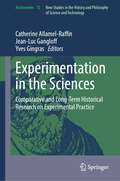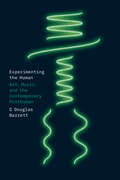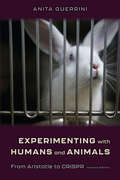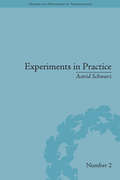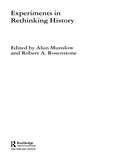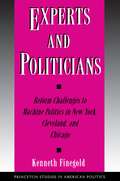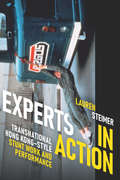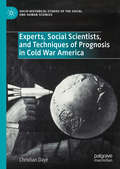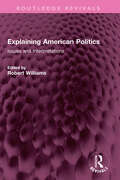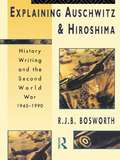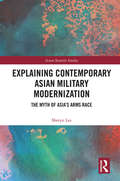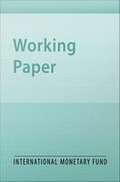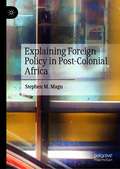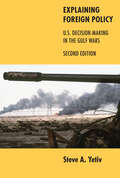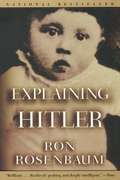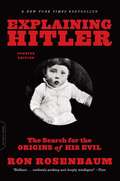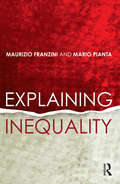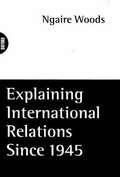- Table View
- List View
Experimentation in the Sciences: Comparative and Long-Term Historical Research on Experimental Practice (Archimedes #72)
by Yves Gingras Catherine Allamel-Raffin Jean-Luc GangloffThis book takes a novel approach by highlighting comparative and long-term historical perspectives on experimental practice. The juxtaposition of accounts of natural, social, and medical experimentation is very enlightening, especially because the authors put the emphasis on the different kinds of objects of experimentation (physical matter, chemical reagents, social groups, organizations, sick individuals, archeological remains) and demonstrate how much the kinds of objects matter for the practice of experimentation, its methods, tools, and methodologies. Taken together, the chapters raise several fascinating questions for further study: What do these different approaches have in common? Why do we call them “experimentation”? What are the intersections among the fields and their developments? The volume engages philosophical approaches that are not well known to Anglophone readers (Bachelard, Bergson, Bernard, Canguilhem, among others) and brings to attention a wealth of Francophone secondary literature on past and present scientific experimentation. The collection fills a yawning gap in science, science studies, and philosophy of science teaching, making it particularly valuable philosophers and historians of science in all subfields.
Experimenting the Human: Art, Music, and the Contemporary Posthuman
by G Douglas BarrettAn engaging argument about what experimental music can tell us about being human. In Experimenting the Human, G Douglas Barrett argues that experimental music speaks to the contemporary posthuman, a condition in which science and technology decenter human agency amid the uneven temporality of postwar global capitalism. Time moves forward for some during this period, while it seems to stand still or even move backward for others. Some say we’re already posthuman, while others endure the extended consequences of never having been considered fully human in the first place. Experimental music reflects on this state, Barrett contends, through its interdisciplinary involvements in postwar science, technology, and art movements. Rather than pursuing the human's beyond, experimental music addresses the social and technological conditions that support such a pursuit. Barrett locates this tendency of experimentalism throughout its historical entanglements with cybernetics, and in his intimate analysis of Alvin Lucier’s neurofeedback music, Pamela Z’s BodySynth performances, Nam June Paik’s musical robotics, Pauline Oliveros’s experiments with radio astronomy, and work by Laetitia Sonami, Yasunao Tone, and Jerry Hunt. Through a unique meeting of music studies, media theory, and art history, Experimenting the Human provides fresh insights into what it means to be human.
Experimenting the Human: Art, Music, and the Contemporary Posthuman
by G Douglas BarrettAn engaging argument about what experimental music can tell us about being human. In Experimenting the Human, G Douglas Barrett argues that experimental music speaks to the contemporary posthuman, a condition in which science and technology decenter human agency amid the uneven temporality of postwar global capitalism. Time moves forward for some during this period, while it seems to stand still or even move backward for others. Some say we’re already posthuman, while others endure the extended consequences of never having been considered fully human in the first place. Experimental music reflects on this state, Barrett contends, through its interdisciplinary involvements in postwar science, technology, and art movements. Rather than pursuing the human's beyond, experimental music addresses the social and technological conditions that support such a pursuit. Barrett locates this tendency of experimentalism throughout its historical entanglements with cybernetics, and in his intimate analysis of Alvin Lucier’s neurofeedback music, Pamela Z’s BodySynth performances, Nam June Paik’s musical robotics, Pauline Oliveros’s experiments with radio astronomy, and work by Laetitia Sonami, Yasunao Tone, and Jerry Hunt. Through a unique meeting of music studies, media theory, and art history, Experimenting the Human provides fresh insights into what it means to be human.
Experimenting the Human: Art, Music, and the Contemporary Posthuman
by G Douglas BarrettAn engaging argument about what experimental music can tell us about being human. In Experimenting the Human, G Douglas Barrett argues that experimental music speaks to the contemporary posthuman, a condition in which science and technology decenter human agency amid the uneven temporality of postwar global capitalism. Time moves forward for some during this period, while it seems to stand still or even move backward for others. Some say we’re already posthuman, while others endure the extended consequences of never having been considered fully human in the first place. Experimental music reflects on this state, Barrett contends, through its interdisciplinary involvements in postwar science, technology, and art movements. Rather than pursuing the human's beyond, experimental music addresses the social and technological conditions that support such a pursuit. Barrett locates this tendency of experimentalism throughout its historical entanglements with cybernetics, and in his intimate analysis of Alvin Lucier’s neurofeedback music, Pamela Z’s BodySynth performances, Nam June Paik’s musical robotics, Pauline Oliveros’s experiments with radio astronomy, and work by Laetitia Sonami, Yasunao Tone, and Jerry Hunt. Through a unique meeting of music studies, media theory, and art history, Experimenting the Human provides fresh insights into what it means to be human.
Experimenting with Humans and Animals: From Aristotle to CRISPR (Johns Hopkins Introductory Studies in the History of Science)
by Anita GuerriniExamining the ideas and attitudes that encourage scientists to experiment on living creatures, what their justifications are, and how these have changed over time.Experimentation on animals—particularly humans—is often assumed to be a uniquely modern phenomenon. But the ideas and attitudes that encourage biological and medical scientists to experiment on living creatures date from the earliest expressions of Western thought. In Experimenting with Humans and Animals, Anita Guerrini looks at the history of these practices and examines the philosophical and ethical arguments that justified them.Guerrini discusses key historical episodes in the use of living beings in science and medicine, including the discovery of blood circulation, the development of smallpox and polio vaccines, and recent research in genetics, ecology, and animal behavior. She also explores the rise of the antivivisection movement in Victorian England, the modern animal rights movement, and current debates over gene therapy and genetically engineered animals. We learn how perceptions and understandings of human and animal pain have changed; how ideas of class, race, and gender have defined the human research subject; and that the ethical values of science seldom stray far from the society in which scientists live and work.Thoroughly rewritten and updated, with new material in every chapter, the book emphasizes a broader understanding of experimentation and adds material on gene therapy, self-experimentation, and prisoners and slaves as experimental subjects. A new chapter brings the story up to the present while reflecting on the current regulatory scene, new developments in science, and emerging genomics. Experimenting with Humans and Animals offers readers a context within which to understand more fully the responsibility we all bear for the suffering inflicted on other living beings in the name of scientific knowledge.
Experiments in Immersive, One-to-One Performance: Understanding Audience Experience through Sensory Engagement (Audience Research)
by Natalia EslingThis book investigates audience experience through the lens of sensory engagement in immersive, one-to-one performance. It presents a distinct, practice-based research (PBR) framework – a performance research ‘laboratory’ – designed to evaluate the effects on diverse audience experiences of two ‘sense-specific manipulations’: eye masks and touch. Through a qualitative analysis of responses from seventy-four individual audience participants, this book offers insight into how these popular ‘immersing’ strategies might be experienced. What do these strategies achieve? How do audience participants make sense of them? Do audience responses align with artistic intentions? And how does the PBR framework designed to address these questions influence the outcomes? Through an analysis of three sets of one-to-one performance experiments generating comparative data about the experience of sense-specific manipulation, this book proposes the utility of merging methodologies in artistic research with empirical audience research in theatre and performance studies. This study offers a new perspective on the value of sensory-focused, immersive, one-to-one experience as a means of resensitizing audience participants through performance.
Experiments in Practice (History and Philosophy of Technoscience #2)
by Astrid SchwarzTraditionally experimentation has been understood as an activity performed within the laboratory, but in the twenty-first century this view is being challenged. Schwarz uses ecological and environmental case studies to show how scientific experiments can transcend the laboratory.
Experiments in Rethinking History
by Robert A. Rosenstone Alun MunslowFrom two of the world’s leading postmodern historians, this thoroughly original collection of articles allows students and researchers to understand and learn important new ways of thinking and writing about the past. This book includes a thorough two-part introduction on theory and practice as well as introductory material in each section that allows the reader to fully engage with the theoretical aspects of the book. It provides a deeper understanding of how to engage with the past today. Fourteen thought-provoking experimental pieces of historical writing tackle subjects as diverse as lynching in South Carolina, the life of an eighteenth-century Marquise, and a journey to a string of Pacific islands, and demonstrates how little-considered factors such as the impact of emotions, authorial subjectivity, the confining character of boundaries, and even a sense of boredom with conventional historical writing practices, can intrude on historical practice This text works as a Reader companion alongside the Routledge best-seller Rethinking History and provides students with an innovative, engaging and easy-to-read research tool to enhance all history-related course studies.
Experiments, Models, Paper Tools: Cultures of Organic Chemistry in the Nineteenth Century (Writing Science Ser. #61)
by Ursula KleinIn the early nineteenth century, chemistry emerged in Europe as a truly experimental discipline. What set this process in motion, and how did it evolve? Experimentalization in chemistry was driven by a seemingly innocuous tool: the sign system of chemical formulas invented by the Swedish chemist Jacob Berzelius. By tracing the history of this "paper tool," the author reveals how chemistry quickly lost its orientation to natural history and became a major productive force in industrial society. These formulas were not merely a convenient shorthand, but productive tools for creating order amid the chaos of early nineteenth-century organic chemistry. With these formulas, chemists could create a multifaceted world on paper, which they then correlated with experiments and the traces produced in test tubes and flasks. The author's semiotic approach to the formulas allows her to show in detail how their particular semantic and representational qualities made them especially useful as paper tools for productive application.
Expertise, Authority and Control: The Australian Army Medical Corps in the First World War (Australian Army History Series)
by Alexia MoncrieffExpertise, Authority and Control charts the development of Australian military medicine in the First World War in the first major study of the Australian Army Medical Corp in over seventy years. It examines the provision of medical care to Australian soldiers during the Dardanelles campaign and explores the imperial and medical-military hierarchies that were blended and challenged during the campaign. By the end of 1918, the AAMC was a radically different organisation. Using army orders, unit war diaries and memoranda written to disseminate information within the Australian Imperial Forces (AIF) and between British and Australian soldiers, it maps the provision of medical care through casualty clearance and evacuation, rehabilitation, and the prevention and treatment of venereal disease. In doing so, she reassesses Australian military medicine and maps the transition to an infrastructure for the AIF in the field, especially in response to conflicts with traditional imperial, military and medical hierarchies.
Experts and Politicians: Reform Challenges to Machine Politics in New York, Cleveland, and Chicago (Princeton Studies in American Politics: Historical, International, and Comparative Perspectives #178)
by Kenneth FinegoldDuring the Progressive Era, reform candidates in New York, Cleveland, and Chicago challenged the status quo--with strikingly different results: brief triumph in New York, sustained success in Cleveland, and utter failure in Chicago. Kenneth Finegold seeks to explain this phenomenon by analyzing the support for reform in these cities, especially the role of an emerging class of urban policy professionals in each campaign. His work offers a new way of looking at urban reform opposition to machine politics. Drawing on original research and quantitative analysis of electoral data, Finegold identifies three distinct patterns of support for reform candidates: traditional reformers drew support from native-stock elites; municipal populists found support among stock immigrant groups and segments of the working class; and progressive candidates won the backing of coalitions made up of traditional reform and municipal populist voters. The success of these reform efforts, Finegold shows, depended on the different ways in which experts were incorporated into city politics. This book demonstrates the significance of expertise as a potential source of change in American politics and policy, and of each city's electoral and administrative organizations as mediating institutions within a national system of urban political economies.
Experts in Action: Transnational Hong Kong–Style Stunt Work and Performance
by Lauren SteimerAction movie stars ranging from Jackie Chan to lesser-known stunt women and men like Zoë Bell and Chad Stahelski stun their audiences with virtuosic martial arts displays, physical prowess, and complex fight sequences. Their performance styles originate from action movies that emerged in the industrial environment of 1980s Hong Kong. In Experts in Action Lauren Steimer examines how Hong Kong--influenced cinema aesthetics and stunt techniques have been taken up, imitated, and reinvented in other locations and production contexts in Hollywood, New Zealand, and Thailand. Foregrounding the transnational circulation of Hong Kong--influenced films, television shows, stars, choreographers, and stunt workers, she shows how stunt workers like Chan, Bell, and others combine techniques from martial arts, dance, Peking opera, and the history of movie and television stunting practices to create embodied performances that are both spectacular and, sometimes, rendered invisible. By describing the training, skills, and labor involved in stunt work as well as the location-dependent material conditions and regulations that impact it, Steimer illuminates the expertise of the workers whose labor is indispensable to some of the world's most popular movies.
Experts, Activists, and Democratic Politics
by T. K. Ahn Robert Huckfeldt John Barry Ryan T. K. Ahn Robert HuckfeldtThis book addresses opinion leadership in democratic politics as a process whereby individuals send and receive information through their informally based networks of political communication. The analyses are based on a series of small group experiments, conducted by the authors, which build on accumulated evidence from more than seventy years of survey data regarding political communication among interdependent actors. The various experimental designs provide an opportunity to assess the nature of the communication process, both in terms of increasing citizen expertise as well as in terms of communicating political biases.
Experts, Social Scientists, and Techniques of Prognosis in Cold War America (Socio-Historical Studies of the Social and Human Sciences)
by Christian DayéThis book describes how Cold War researchers used expert opinions to construct foreknowledge of geopolitical relevance. Focusing on the RAND Corporation, an American think tank with close relations to the armed forces, Dayé analyses the development of two techniques of prognosis, the Delphi technique and Political Gaming. Based on archival research and interviews, the chapters explore the history of this series of experiments to understand how contemporary social scientists conceived of one of the core categories of the Cold War, the expert, and uncover the systematic use of expert opinions to craft prognoses. This consideration of the expert’s role in Cold War society and what that can tell us about the role of the expert today will be of interest to students and scholars across the history of science, the sociology of knowledge, future studies, the history of the Cold War, social science methodology, and social policy.
Explaining American Politics: Issues and Interpretations (Routledge Revivals)
by Robert WilliamsFirst published in 1990, Explaining American Politics looks at substantial and specific problems in American politics. Focusing on the key issues in contemporary American government, the contributors give lively and provocative interpretations of controversial topics such as the New Right, perceptions of the Presidency, the alleged irresponsibility of Congress, the workings of bureaucracy, Supreme Court activism, and the decline of political parties. This book will be indispensable to all students of American politics as well as to the reader who wants to understand what is really happening in the world’s most complex and fascinating political system.
Explaining Auschwitz and Hiroshima: Historians and the Second World War, 1945-1990 (The New International History)
by Richard J. BosworthFirst published in 1993. Routledge is an imprint of Taylor & Francis, an informa company.
Explaining Contemporary Asian Military Modernization: The Myth of Asia’s Arms Race (Asian Security Studies)
by Sheryn LeeThis book proposes a novel theoretical framework of "interactive arming" in order to explain armament dynamics in contemporary Asia. Frequently, the modernisation of contemporary naval forces in Asia is described as an "arms race," with the underlying assumption being that weapons acquisitions and increases in defence expenditure are competitive and bilateral and due to conflicting purposes or mutual fears. This book argues that the concept of an arms race is an unsuitable one for explaining contemporary military modernisation in 21st-century Asia. Instead, it proposes a novel and innovative concept of "interactive arming" and argues that what drives conflict is political rivalry, not weapons acquisitions. Instead of perceiving arming as abnormal behaviour, the book views arming as a natural strategic behaviour of states and military modernisation as a basic requirement for a state’s ability to survive. This book will be of much interest to students of Asian security, strategic studies and international relations in general.
Explaining Episodes of Growth Accelerations, Decelerations, and Collapses in Western Africa
by Patrick Imam Gonzalo SalinasA report from the International Monetary Fund.
Explaining Foreign Policy in Post-Colonial Africa
by Stephen M. MaguThis book explores foreign policy developments in post-colonial Africa. A continental foreign policy is a tenuous proposition, yet new African states emerged out of armed resistance and advocacy from regional allies such as the Bandung Conference and the League of Arab States. Ghana was the first Sub-Saharan African country to gain independence in 1957. Fourteen more countries gained independence in 1960 alone, and by May 1963, when the Organisation of African Unity (OAU) was formed, 30 countries were independent. An early OAU committee was the African Liberation Committee (ALC), tasked to work in the Frontline States (FLS) to support independence in Southern Africa. Pan-Africanists, in alliance with Brazzaville, Casablanca and Monrovia groups, approached continental unity differently, and regionalism continued to be a major feature. Africa’s challenges were often magnified by the capitalist-democratic versus communist-socialist bloc rivalry, but through Africa’s use and leveraging of IGOs – the UN, UNDP, UNECA, GATT, NIEO and others – to advance development, the formation of the African Economic Community, OAU’s evolution into the AU and other alliances belied collective actions, even as Africa implemented decisions that required cooperation: uti possidetis (maintaining colonial borders), containing secession, intra- and inter-state conflicts, rebellions and building RECs and a united Africa as envisioned by Pan Africanists worked better collectively.
Explaining Foreign Policy: U.S. Decision-Making in the Gulf Wars
by Steve A. YetivSteve A. Yetiv has developed an interdisciplinary, integrated approach to studying foreign policy decisions, which he applies here to understand better how and why the United States went to war in the Persian Gulf in 1991 and 2003. Yetiv's innovative method employs the rational actor, cognitive, domestic politics, groupthink, and bureaucratic politics models to explain the foreign policy behavior of governments. Drawing on the widest set of primary sources to date-including a trove of recently declassified documents-and on interviews with key actors, he applies these models to illuminate the decision-making process in the two Gulf Wars and to develop theoretical notions about foreign policy. What Yetiv discovers, in addition to empirical evidence about the Persian Gulf and Iraq wars, is that no one approach provides the best explanation, but when all five are used, a fuller and more complete understanding emerges. Thoroughly updated with a new preface and a chapter on the 2003 Iraq War, Explaining Foreign Policy, already widely used in courses, will continue to be of interest to students and scholars of foreign policy, international relations, and related fields.
Explaining Foreign Policy: U.S. Decision-Making in the Gulf Wars
by Steve A. YetivSteve A. Yetiv has developed an interdisciplinary, integrated approach to studying foreign policy decisions, which he applies here to understand better how and why the United States went to war in the Persian Gulf in 1991 and 2003. Yetiv’s innovative method employs the rational actor, cognitive, domestic politics, groupthink, and bureaucratic politics models to explain the foreign policy behavior of governments. Drawing on the widest set of primary sources to date—including a trove of recently declassified documents—and on interviews with key actors, he applies these models to illuminate the decision-making process in the two Gulf Wars and to develop theoretical notions about foreign policy. What Yetiv discovers, in addition to empirical evidence about the Persian Gulf and Iraq wars, is that no one approach provides the best explanation, but when all five are used, a fuller and more complete understanding emerges.Thoroughly updated with a new preface and a chapter on the 2003 Iraq War, Explaining Foreign Policy, already widely used in courses, will continue to be of interest to students and scholars of foreign policy, international relations, and related fields.
Explaining Hitler: The Search for the Origins of His Evil
by Ron RosenbaumDocuments a variety of authors' takes on the reasons behinds Hitler's actions.
Explaining Hitler: The Search for the Origins of His Evil, updated edition
by Ron RosenbaumIn Explaining Hitler, Ron Rosenbaum investigates the meanings and motivations people have attached to Hitler and his crimes against humanity. What does Hitler tell us about the nature of evil? In often dramatic encounters, Rosenbaum confronts historians, scholars, filmmakers, and deniers as he skeptically analyzes the key strains of Hitler interpretation. A balanced and thoughtful overview of a subject both frightening and profound, this is an extraordinary quest, an expedition into the war zone of Hitler theories, "a provocative work of cultural history that is as compelling as it is thoughtful, as readable as it is smart” (New York Times). First published in 1998 to rave reviews, Explaining Hitler became a New York Times-bestseller. This new edition is an update of that classic and a critically important contribution to the study of the twentieth century’s darkest moment.
Explaining Inequality
by Maurizio Franzini Mario PiantaInequalities in incomes and wealth have increased in advanced countries, making our economies less dynamic, our societies more unjust and our political processes less democratic. As a result, reducing inequalities is now a major economic, social and political challenge. This book provides a concise yet comprehensive overview of the economics of inequality. Until recently economic inequality has been the object of limited research efforts, attracting only modest attention in the political arena; despite important advances in the knowledge of its dimensions, a convincing understanding of the mechanisms at its roots is still lacking. This book summarizes the topic and provides an interpretation of the mechanisms responsible for increased disparities. Building on this analysis the book argues for an integrated set of policies addressing the roots of inequalities in incomes and wealth Explaining Inequality will be of interest to students, researchers and practitioners concerned with inequality, economic and public policy and political economy.
Explaining International Relations Since 1945
by Ngaire WoodsThe book is a collection of 16 articles on international relations by leading authors in the field. It discusses new theoretical concepts with numerous examples taken from world events. The effectiveness of the UN, NATO, SEATO, the EEC, etc. is discussed in detail.
